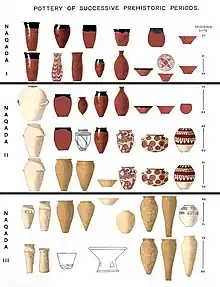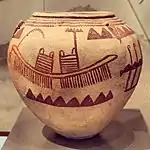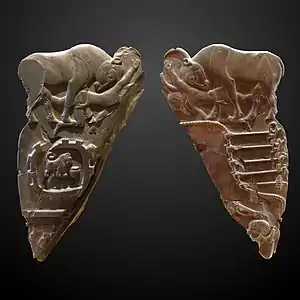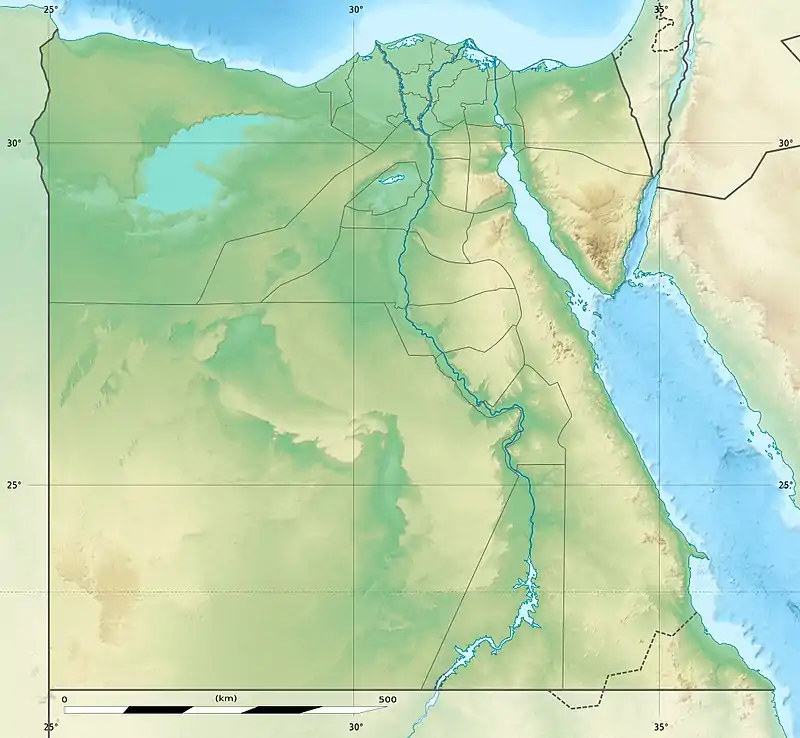Naqada culture
The Naqada culture is an archaeological culture of Chalcolithic Predynastic Egypt (ca. 4000–3000 BC), named for the town of Naqada, Qena Governorate. A 2013 Oxford University radio carbon dating study of the Predynastic period, however, suggests a much later date beginning sometime between 3,800 and 3,700 BC.[1]
| Geographical range | Egypt |
|---|---|
| Period | Neolithic |
| Dates | c. 4000 – 3000 BC |
| Type site | Naqada |
| Preceded by | Badarian culture |
| Followed by | Protodynastic Period |
The final phase of the Naqada culture is Naqada III, which is coterminous with the Protodynastic Period (Early Bronze Age, ca. 3200–3000 BCE) in ancient Egypt.
Chronology
William Flinders Petrie
The Naqada period was first divided by the British Egyptologist William Flinders Petrie, who explored the site in 1894, into three sub-periods:
Werner Kaiser

Petrie's chronology was superseded by that of Werner Kaiser in 1957. Kaiser's chronology began c. 4000 BC, but the modern version has been adjusted slightly, as follows:[2]
- Naqada I (about 3900–3650 BC)
- black-topped and painted pottery
- trade with Nubia, Western Desert oases, and Eastern Mediterranean[3]
- obsidian from Ethiopia[4]
- Naqada II (about 3650–3300 BC)
- represented throughout Egypt
- first marl pottery, and metalworking
- Naqada III (about 3300–2900 BC)
- more elaborate grave goods, first Pharaohs
- cylindrical jars
- writing
 Figure of a woman with bird traits. Naqada II period, 3500–3400 BCE. Brooklyn Museum
Figure of a woman with bird traits. Naqada II period, 3500–3400 BCE. Brooklyn Museum Pre-dynastic Naqada cooking pot - scientific analysis has shown that this pot once contained a meat stew with honey
Pre-dynastic Naqada cooking pot - scientific analysis has shown that this pot once contained a meat stew with honey Incised hippopotamus ivory tusk, an upper canine with four holes around top, from Naqada Tomb 1419, Egypt, Naqada period, The Petrie Museum of Egyptian Archaeology, London
Incised hippopotamus ivory tusk, an upper canine with four holes around top, from Naqada Tomb 1419, Egypt, Naqada period, The Petrie Museum of Egyptian Archaeology, London Spatha shell from Naqada tomb 1539, Egypt, Naqada I period, The Petrie Museum of Egyptian Archaeology, London
Spatha shell from Naqada tomb 1539, Egypt, Naqada I period, The Petrie Museum of Egyptian Archaeology, London Naqada D-ware jar with image of a boat
Naqada D-ware jar with image of a boat Bull Palette
Bull Palette The Battlefield Palette, 3100 B.C.
The Battlefield Palette, 3100 B.C.
.jpg.webp) The Gebel el-Arak Knife, Musée du Louvre (3300-3200 BCE).
The Gebel el-Arak Knife, Musée du Louvre (3300-3200 BCE).
Monuments and excavations

Predynastic Egyptians in the Naqada I period traded with Nubia to the south, the oases of the western desert to the west, and the cultures of the eastern Mediterranean to the east.[8] They also imported obsidian from Ethiopia to shape blades and other objects from flakes.[9] Charcoal samples found in the tombs of Nekhen, which were dated to the Naqada I and II periods, have been identified as cedar from Lebanon.[10]
Craniometric analysis of predynastic Naqada fossils found that they were closely related to other Afroasiatic-speaking populations inhabiting the Horn of Africa and the Maghreb, as well as to Bronze Age and medieval period Nubians and to specimens from ancient Jericho. The Naqada skeletons were also morphologically proximate to modern osteological series from Europe and the Indian subcontinent. However, the Naqada fossils and these ancient and recent skeletons were phenotypically distinct from fossils belonging to modern Niger-Congo-speaking populations inhabiting Tropical Africa, as well as from Mesolithic skeletons excavated at Wadi Halfa in the Nile Valley.[11]
Relative chronology
References
- https://www.newscientist.com/article/dn24145-carbon-dating-shows-ancient-egypts-rapid-expansion/
- Hendrickx, Stan. "The relative chronology of the Naqada culture: Problems and possibilities [in:] Spencer, A.J. (ed.), Aspects of Early Egypt. London: British Museum Press, 1996: 36-69": 64. Cite journal requires
|journal=(help) - Shaw, Ian (2002). The Oxford History of Ancient Egypt. Oxford, England: Oxford University Press. p. 61. ISBN 0-500-05074-0.
- Barbara G. Aston, James A. Harrell, Ian Shaw (2000). Paul T. Nicholson and Ian Shaw editors. "Stone," in Ancient Egyptian Materials and Technology, Cambridge, 5-77, pp. 46-47. Also note: Barbara G. Aston (1994). "Ancient Egyptian Stone Vessels," Studien zur Archäologie und Geschichte Altägyptens 5, Heidelberg, pp. 23-26. (See on-line posts: and .)
- "UCLA Encyclopedia of Egyptology" (PDF).
- "Naqada, ivory carvings". www.ucl.ac.uk.
- Petrie, William Matthew Flinders (1895). Naqada and Ballas. p. 213.
- Shaw, Ian (2002). The Oxford History of Ancient Egypt. Oxford, England: Oxford University Press. p. 61. ISBN 0-500-05074-0.
- Barbara G. Aston, James A. Harrell, Ian Shaw (2000). Paul T. Nicholson and Ian Shaw editors. "Stone," in Ancient Egyptian Materials and Technology, Cambridge, 5-77, pp. 46-47. Also note: Barbara G. Aston (1994). "Ancient Egyptian Stone Vessels", Studien zur Archäologie und Geschichte Altägyptens 5, Heidelberg, pp. 23-26. See on-line posts: [3] and [4].
- Parsons, Marie. "Egypt: Hierakonpolis, A Feature Tour Egypt Story". www.touregypt.net. Retrieved 2008-07-09.
- Brace, C. Loring et al. (1993). "Clines and clusters versus "race:" a test in ancient Egypt and the case of a death on the Nile". American Journal of Physical Anthropology. 36 (S17): 1–31. doi:10.1002/ajpa.1330360603. Retrieved 1 November 2017.CS1 maint: uses authors parameter (link); also cf. Haddow (2012) for similar dental trait analysis
- Liverani, Mario (2013). The Ancient Near East: History, Society and Economy. Routledge. p. 13, Table 1.1 "Chronology of the Ancient Near East". ISBN 9781134750917.
- Shukurov, Anvar; Sarson, Graeme R.; Gangal, Kavita (7 May 2014). "The Near-Eastern Roots of the Neolithic in South Asia". PLOS ONE. 9 (5): e95714. Bibcode:2014PLoSO...995714G. doi:10.1371/journal.pone.0095714. ISSN 1932-6203. PMC 4012948. PMID 24806472.
- Bar-Yosef, Ofer; Arpin, Trina; Pan, Yan; Cohen, David; Goldberg, Paul; Zhang, Chi; Wu, Xiaohong (29 June 2012). "Early Pottery at 20,000 Years Ago in Xianrendong Cave, China". Science. 336 (6089): 1696–1700. Bibcode:2012Sci...336.1696W. doi:10.1126/science.1218643. ISSN 0036-8075. PMID 22745428.
- Thorpe, I. J. (2003). The Origins of Agriculture in Europe. Routledge. p. 14. ISBN 9781134620104.
- Price, T. Douglas (2000). Europe's First Farmers. Cambridge University Press. p. 3. ISBN 9780521665728.
- Jr, William H. Stiebing; Helft, Susan N. (2017). Ancient Near Eastern History and Culture. Routledge. p. 25. ISBN 9781134880836.
| Wikimedia Commons has media related to Naqada culture. |


